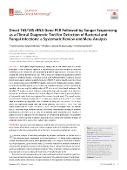| dc.contributor.author | Dřevínek, Pavel | |
| dc.contributor.author | Hollweck, Regina | |
| dc.contributor.author | Lorenz, Michael G | |
| dc.contributor.author | Lustig, Michael | |
| dc.contributor.author | Bjarnsholt, Thomas | |
| dc.date.accessioned | 2023-12-13T11:40:39Z | |
| dc.date.available | 2023-12-13T11:40:39Z | |
| dc.date.issued | 2023 | |
| dc.identifier.uri | https://hdl.handle.net/20.500.14178/2115 | |
| dc.description.abstract | rRNA gene Sanger sequencing is being used for the identification of cultured pathogens. A new diagnostic approach is sequencing of uncultured samples by using the commercial DNA extraction and sequencing platform SepsiTest (ST). The goal was to analyze the clinical performance of ST with a focus on nongrowing pathogens and the impact on antibiotic therapy. A literature search used PubMed/Medline, Cochrane, Science Direct, and Google Scholar. Eligibility followed PRISMA-P criteria. Quality and risk of bias were assessed drawing on QUADAS-2 (quality assessment of diagnostic accuracy studies, revised) criteria. Meta-analyses were performed regarding accuracy metrics compared to standard references and the added value of ST in terms of extra found pathogens. We identified 25 studies on sepsis, infectious endocarditis, bacterial meningitis, joint infections, pyomyositis, and various diseases from routine diagnosis. Patients with suspected infections of purportedly sterile body sites originated from various hospital wards. The overall sensitivity (79%; 95% confidence interval [CI], 73 to 84%) and specificity (83%; 95% CI, 72 to 90%) were accompanied by large effect sizes. ST-related positivity was 32% (95% CI, 30 to 34%), which was significantly higher than the culture positivity (20%; 95% CI, 18 to 22%). The overall added value of ST was 14% (95% CI, 10 to 20%) for all samples. With 130 relevant taxa, ST uncovered high microbial richness. Four studies demonstrated changes of antibiotic treatment at 12% (95% CI, 9 to 15%) of all patients upon availability of ST results. ST appears to be an approach for the diagnosis of nongrowing pathogens. The potential clinical role of this agnostic molecular diagnostic tool is discussed regarding changes of antibiotic treatment in cases where culture stays negative. | en |
| dc.language.iso | en | |
| dc.relation.url | https://doi.org/10.1128/jcm.00338-23 | |
| dc.rights | Creative Commons Uveďte původ 4.0 International | cs |
| dc.rights | Creative Commons Attribution 4.0 International | en |
| dc.title | Direct 16S/18S rRNA Gene PCR Followed by Sanger Sequencing as a Clinical Diagnostic Tool for Detection of Bacterial and Fungal Infections: a Systematic Review and Meta-Analysis | en |
| dcterms.accessRights | openAccess | |
| dcterms.license | https://creativecommons.org/licenses/by/4.0/legalcode | |
| dc.date.updated | 2023-12-13T11:40:39Z | |
| dc.subject.keyword | added value of sequencing | en |
| dc.subject.keyword | agnostic molecular diagnosis | en |
| dc.subject.keyword | bacterial meningitis | en |
| dc.subject.keyword | change of antibiotic treatment | en |
| dc.subject.keyword | culture-negative infections | en |
| dc.subject.keyword | fastidious and rare pathogens | en |
| dc.subject.keyword | infectious endocarditis | en |
| dc.subject.keyword | joint infections | en |
| dc.subject.keyword | nongrowing pathogens | en |
| dc.subject.keyword | sepsis | en |
| dc.relation.fundingReference | info:eu-repo/grantAgreement/MSM//LX22NPO5103 | |
| dc.relation.fundingReference | info:eu-repo/grantAgreement/FN/I-FN/I-FNM | |
| dc.date.embargoStartDate | 2023-12-13 | |
| dc.type.obd | 73 | |
| dc.type.version | info:eu-repo/semantics/publishedVersion | |
| dc.identifier.doi | 10.1128/jcm.00338-23 | |
| dc.identifier.utWos | 001017083700001 | |
| dc.identifier.eidScopus | 2-s2.0-85171900058 | |
| dc.identifier.obd | 633386 | |
| dc.identifier.pubmed | 37367430 | |
| dc.subject.rivPrimary | 30000::30300::30303 | |
| dcterms.isPartOf.name | Journal of Clinical Microbiology | |
| dcterms.isPartOf.issn | 0095-1137 | |
| dcterms.isPartOf.journalYear | 2023 | |
| dcterms.isPartOf.journalVolume | 61 | |
| dcterms.isPartOf.journalIssue | 9 | |
| uk.faculty.primaryId | 109 | |
| uk.faculty.primaryName | 2. lékařská fakulta | cs |
| uk.faculty.primaryName | Second Faculty of Medicine | en |
| uk.faculty.secondaryId | 52 | |
| uk.faculty.secondaryName | Fakultní nemocnice v Motole | cs |
| uk.faculty.secondaryName | Motol University Hospital | en |
| uk.department.primaryId | 109 | |
| uk.department.primaryName | 2. lékařská fakulta | cs |
| uk.department.primaryName | Second Faculty of Medicine | en |
| uk.department.secondaryId | 1701 | |
| uk.department.secondaryId | 100010693902 | |
| uk.department.secondaryName | Ústav lékařské mikrobiologie | cs |
| uk.department.secondaryName | Ústav lékařské mikrobiologie | en |
| uk.department.secondaryName | Ústav lékařské mikrobiologie 2. LF UK a FN Motol | cs |
| uk.department.secondaryName | Department of Medical Microbiology, 2nd Faculty of Medicine and Motol University Hospital | en |
| dc.type.obdHierarchyCs | ČLÁNEK V ČASOPISU::článek v časopisu::přehledový článek | cs |
| dc.type.obdHierarchyEn | JOURNAL ARTICLE::journal article::summarizing article | en |
| dc.type.obdHierarchyCode | 73::152::205 | en |
| uk.displayTitle | Direct 16S/18S rRNA Gene PCR Followed by Sanger Sequencing as a Clinical Diagnostic Tool for Detection of Bacterial and Fungal Infections: a Systematic Review and Meta-Analysis | en |

